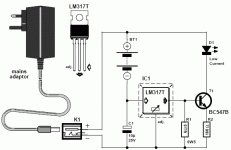Hello! I have two (probably) low-quality NiMH 1.2V 2700mAh batteries lying around, and i want to make some use of them, but first i have to charge them. They could already be dead, but i want to try. As you see, they are not worth investing in (bying or constructing a sophisticated fast charger), so i will go with really 'the bare minimum'. The schematic in the attachment should do the job, but i have a question: should i have a voltage regulator in front of the batteries and current regulator, so that the voltage across a cell in exactly rigtht. In the article where i saw the schematic they said that your supply voltage should be less than needed and you have to consider the 1.25V reference voltage and the dropout voltage of the IC. But what happens if your supply is, say, 12V and you are charging 2 cells. That makes roughly 1.25+2+2*1.5=6.25V. Where does the other 5.75V go? That's why i was considering a voltage regulator in fornt. Do i really need one?
Attachments
1.25V across the 6.8Ω resistor
2*(battery charging voltage) across the batteries
And the rest is across the LM317
A linear series regulator drops the extra voltage across itself to keep load voltage or current (depending on arrangement) as whatever you want it to be.
Dropout voltage is the minimum voltage that needs to be across the regulator in order for it to work properly.
2*(battery charging voltage) across the batteries
And the rest is across the LM317
A linear series regulator drops the extra voltage across itself to keep load voltage or current (depending on arrangement) as whatever you want it to be.
Dropout voltage is the minimum voltage that needs to be across the regulator in order for it to work properly.
Note that this charger should not be left unattended as there is no provision to cross over to trickle charge mode when the batteries are fully charged and it will seriously overcharge the batteries if left for an extended period of time. A better scheme would be to design the charger to output something like 2.6V (for two batteries in series) with a simple current limiter to limit the maximum charge rate to a safe value.
NiMHs can handle getting overcharged (supposedly) infinitely as long as charging current is below 0.1C, or 270mA in this case.
Anyway assuming charging efficiency of 66%, at 1.25V ÷ 6.8Ω = 183.8mA it will take 22 hours to fully charge the battery, a few hours extra won't hurt and is helpful.
Battery charging voltage increases as it gets charged, reaching >1.4V at full charge for NiMH, upon which charging current needs to drop to 0.1C. There can be a basic circuit that charges at 1C @ low battery voltage and 0.1C @ 1.4V, but the increased parts count makes more specialized ICs the better option.
Anyway assuming charging efficiency of 66%, at 1.25V ÷ 6.8Ω = 183.8mA it will take 22 hours to fully charge the battery, a few hours extra won't hurt and is helpful.
Battery charging voltage increases as it gets charged, reaching >1.4V at full charge for NiMH, upon which charging current needs to drop to 0.1C. There can be a basic circuit that charges at 1C @ low battery voltage and 0.1C @ 1.4V, but the increased parts count makes more specialized ICs the better option.
I made one from this circuit back in 2008. And it worked very well that I made another one last week but this time smaller and with SMD.
- Status
- This old topic is closed. If you want to reopen this topic, contact a moderator using the "Report Post" button.
- Home
- General Interest
- Everything Else
- NiMH linear charger?
